

By Alexis Kavros
It is easy to take for granted how integral textiles are in our lives. Every garment you wear from your shoe laces to that dashing cap on your head has a fiber story behind it. And, in my opinion, all those stories are absolutely fascinating. So rove along with me in this inaugural article of The Roving Yarn as we unravel some darn good yarns together!
United Kingdom

Rove Along with Me!
Hello & Hylô! Come along with me as I rove around England and Wales! (in case you’re wondering ‘hylô’ is how you write ‘hello’ in Welsh).
In August of 2024, I was lucky enough to travel to England and Wales with my husband, Andrew. He is as passionate about history as I am about fiber so the two of us had a fantastic time touring castles, seeing roving sheep, and of course learning about historic and significant textiles. In this article I’m sharing some highlights from our journey!
First off, let me say that as a Southern Californian, I was thrilled to visit a climate where I could comfortably wear the luscious wool Malabrigo Magnus Cardigan I had crocheted. I don’t know if I would normally recommend crocheting a big wool cardigan during a Southern California summer in an apartment with no air conditioning, but I was determined to wear it abroad, so I had to finish it. And believe me it got worn - rain or shine, that wool and I wandered! Also, I wasn’t the only one dressed up in fantastic fibers. Just in time for our trip I had knitted the No Sweat Sweatshirt for Andrew. Previously, I had knit only beanies, and I thought ‘oh I’ll do a simple sweater before the trip…’ After nine weeks of knitting classes at the wonderful Wildfiber Studio, I cast off my knitting and tucked it into our luggage.
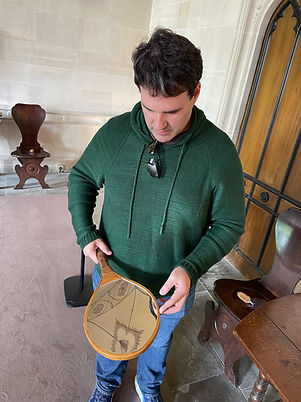

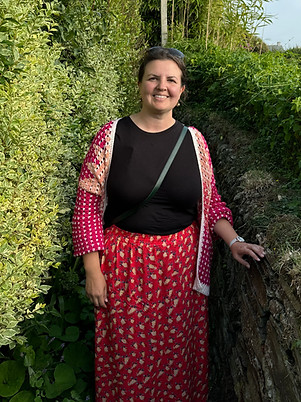
England's Museums
and the Textiles They Hold
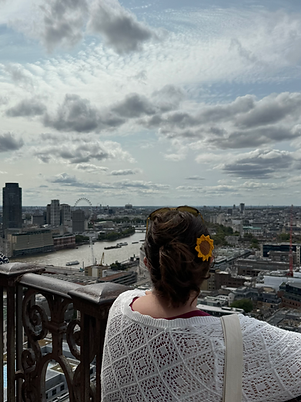
There really are no words to describe the incredible collection found at the British Museum, fiber or otherwise. It is akin to walking into the movie version of the most perfect and magical museum you can imagine, only to find out that it actually exists in real life. I won’t go excessively into their extensive collection, but I would like to touch on a few very interesting items that had some personal significance for me. If you want to digitally visit the museum you can check out their collection online!
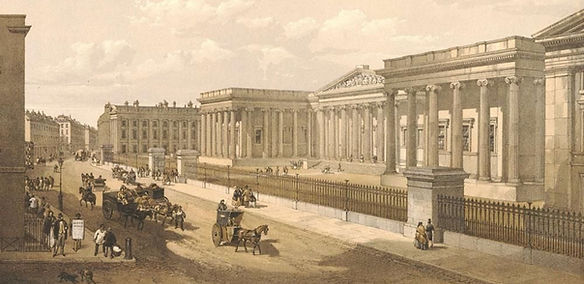
When you think of the difficulties of garment making, you would probably think that the hardest part is getting the right fit or sewing the pieces together. But already you would be so many steps ahead of where the process actually starts. The first step to historical garment making is to look around and find what local resources can be spun, woven, crocheted, knitted or sewn. Are there sheep roving about that can be shorn for their wool? Is there flax or cotton ready to be harvested and spun? What about in harsh arctic climates? How do humans living in resource-scarce locales make their textiles that they surely needed to survive?
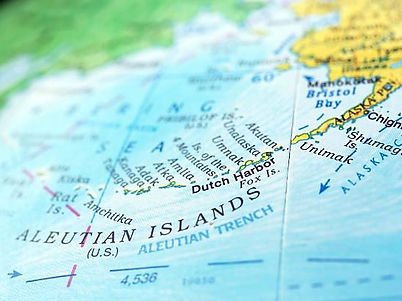
My mother’s side of my family is Unangax̂ (Aleutian). They are the indigenous people of the Aleutian Islands in modern day Alaska. If you’re unfamiliar with those islands, they are the chain of lands that stretch out like a curved finger from mainland Alaska toward Russia. Because these islands are so remote, Unangax̂ traditional arctic clothing is illustrative of an industriousness found in few places on earth.
The British Museum exhibits some of these remarkable garments where every element showcases rich artistry created from scarcity. It would be easy to think that the precious nature of these garment ‘ingredients’ would breed designs wholly based on utility, leaving no room for decorations. However, short supply did not stop these talented artisans from creating textiles with elaborate textures, vivid colors, and complicated design elements that served beauty and fashion. Their creations complement utility in a climate where many of us would think survival would be the only concern.
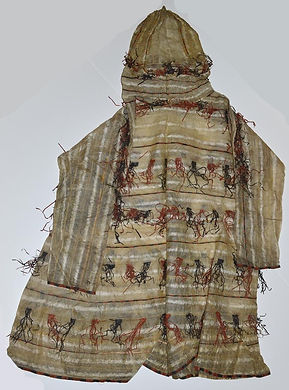
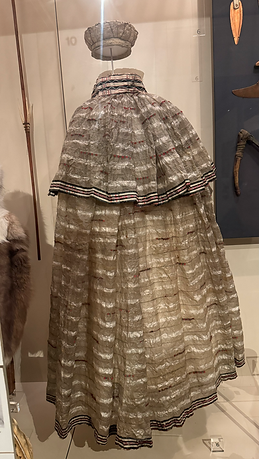
The arctic garments shown here illustrate that commitment to beauty. Constructed with what the Unangax̂ had in abundance, these hardy artisans transformed sea mammals skins, intestines, furs, sinews, and wild grasses into fashion. Look at the vividness of the red tassel elements in this coat! They resemble tufts of yarn but actually what you are looking at is delicately cut and carefully dyed seal intestines. It’s very easy to picture animal-based garments as something heavy, but this couldn’t be more the opposite. These tassels surely have a lightness and movement to them when this coat was taken for a stroll.

Observe the tufts of colorful wool in the seams of this cap. Wool is not found naturally in the Aleutian Islands. The inclusion of precious foreign elements, like the wool above, showcase the presence of trade and the growing development of globalization. I do wonder what natural dye was used to color them since these garments were made before the advent of readily available synthetic dye. There are so many vivid natural dyes out there, and it just takes an industrious eye and a commitment to curiosity to find them. For example, Seelie Studios in Northern California makes a lovely blush pink dye out of sea urchins!
Stay tuned if you’re as fascinated as I am in these arctic artisans and the garments they make. In the summer of 2026, I plan to attend the APIA Culture Camp in Anchorage, Alaska. This program is a week-long artistry and cultural training camp to help the indigenous peoples, their decedents (that’s me!), and those interested to learn about the amazing culture and arts of the Unangax̂ people.
Excessively Woven With Abundance
If you get to know me it becomes pretty apparent that I am absolutely obsessed with elaborate textiles. As we continued in England, I had the chance to see a historic exhibit at the Ashmolean Museum in Oxford, featuring six ornate Japanese kimono belonging to Kabuki actor Bandō Tamasaburō V. Each of the kimono and obi on display are stunning works of art bridging together a spectrum of techniques including spinning, dyeing, weaving, sewing, embroidering, rope-making, and beading. Take a moment to appreciate that these textiles are basically sculptures. The three dimensional spiny lobster is not only elaborate but it is so true to scale that it looks like it just climbed up the kimono.

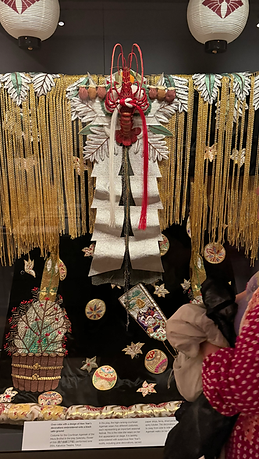
A unique aspect of Kabuki performance is that the actors play a large role in the costume design. It truly is a team effort to create a costume that both hangs beautifully and functions in movement to ‘act’ in line with the intention behind the character. For example, the obi (sash) photographed here portrays a carp swimming upwards. The gold braid ropes hanging in front of the carp sway as the actor moves, bringing the fish to life and making it appear as though it is swiftly swimming skyward.
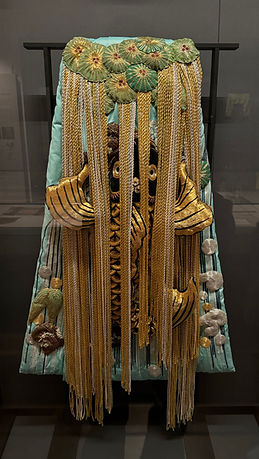
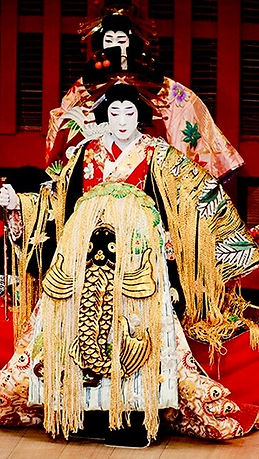
If you happen to find yourself in Oxford, make sure to check out a fantastic yarn shop called The Woolhound, located in the historic Oxford Covered Market (established 1770!) Besides being an absolutely beautiful yarn shop with supplies for knitters and crocheters alike (including British wool!), this charming shop creates some incredible postbox toppers! If you aren’t familiar with postbox toppers, keep reading because I take you along to Exmouth to visit some. In the meantime, peep this beautiful two-ply ‘Manos Del Uruguay’ yarn I picked up at The Woolhound.
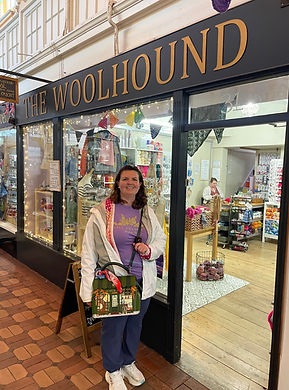
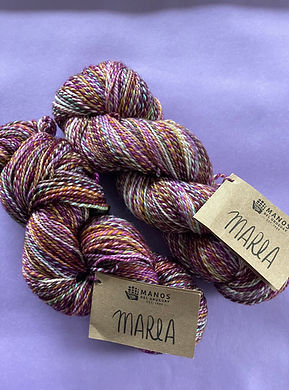
Replace Doom Scrolling
with Drop Spindling

If distinguished shops are your style, then I present to you Chipping Campden Market Hall. Tucked into the Cotswolds, a collection of historic villages, is this market hall, built in 1627 by Sir Baptist Hicks, a wealthy textile merchant. The cobblestone floor photographed here is original. You can see just how worn it is from hundreds of years of feet, hooves and wheels traversing it. There is a question as to whether this specific market hall once held renaissance-era wool merchants. If it didn’t, then other similarly designed market halls certainly did, so at the very least you can picture the hustle and bustle of old. Regardless of what was being sold, these market halls functioned as a place for people to sell their wares, buskers to entertain, and for people to come together as a community. And I can pretty much guarantee that wool was being processed there even if it wasn’t technically a wool market. Allow me to explain…

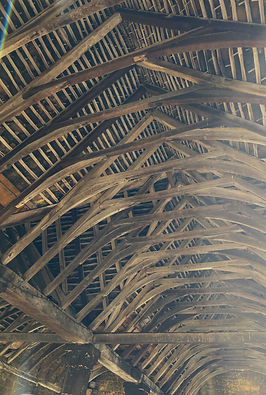
Typically, when one pictures spinning wool the image that comes to mind is a large Sleeping Beauty- esq spinning wheel. These wheels clearly weren’t designed to be rolled around town. However, by using a small hand held tool called a drop spindle, women of the past were able to spin on the go with simply a bit of prepared roving (a long and narrow bundle of combed fiber). In this painting from the medieval manuscript of La Cité de Dieu, you can see women doing just that.

Using the drop spindle, women would walk the fields and spin, work a market stall and spin, and basically do anything and everything while spinning. In fact, the origin of the term ‘spinster’ came about because of the predominance of women who spun wool to provide income for their family. It was an accessible avenue to earn income for women during a time in history when choices were limited. It was an honorable occupation. Women, often even after the death of their husbands, were able to provide for their families and succeed in a world built against their success. Only later did the term ‘spinster’ develop the negative connotation that one associates with it today.
I recently attended a Forage to Fiber workshop in Ojai, California. I got a chance to use a drop spindle to spin my own yarn from wool sheared from sheep that very morning. There is a definitely a learning curve to the process, but I could easily see how these women 400+ years ago were spinning yarn anywhere and everywhere.
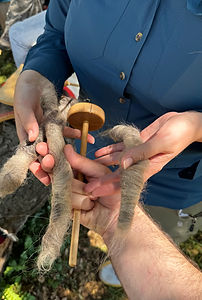


To put it in modern terms, anywhere you can pick up your phone and scroll, in the past you could have been spinning yarn! Check out this video of my wonderful experience at the Forage to Fiber Workshop!


I’m happy to report that while the Chipping Camden Market Hall is old, it is not retired. It continues to serve the community as a place of togetherness and vibrant commerce. Every Friday from 11am-3pm it comes alive and transforms into a bustling place of business as the Chipping Campden Art, Craft and Gift Fair where artisans sell their wares in much the same way as people did 400 years ago. It is all too easy to see ourselves as apart from the people of the past, but my historic counterparts and I all share a mutual appreciation for wool, fiber arts, and community, spinning us closer together.
Call the Midwife!
Someone is in Labor at The Ropery!
Allow me to take you along to one more unique British market. This one isn’t quite as historic, but maybe you’ll find it recognizable? Welcome to Violet Buckle’s Button and Bow Shop from Call the Midwife - my favorite show!


If you want to immediately be my friend, tell me you love Call the Midwife! It follows the life and work of a team of midwives who live in and serve the women and families of Poplar, London from the 1950’s forward. Throughout the show you see beauty, tragedy, community, and lots of fiber arts! This was, after all, a time when ‘make do and mend’ came into being. Whether it’s a signature cranberry cardigan bicycling by, a patient midwife knitting while awaiting a birth, or a glimpse of a crocheted tea cozy tucked in beside a plate of biscuits, the fiber arts are deeply woven into the show.
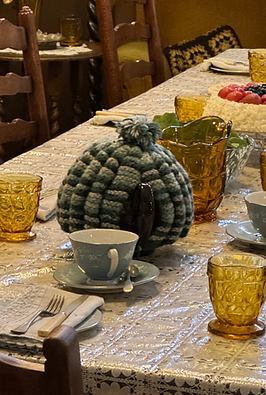
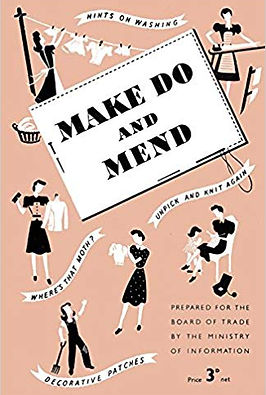

Generally, I visit the world of Call the Midwife through Netflix. However, I was able to visit Violet’s shop by taking a train from Victoria Station in London to the town of Chatham, in Southeast England, to visit the show’s filming location.


These sets exist at the Historic Dockyard of Chatham. This location is ideal because through movie magic (or in this case, television magic!) the set designers can make it appear as though the characters are actually walking through post-WWII London. Now, don’t worry I haven’t strayed from the thread of fiber quite as much as it may seem. You see, the Historical Dockyard of Chatham also houses ‘The Ropery’, which is an 18th century warehouse where naval-grade rope has been made since 1728! In fact, it is the last surviving naval ropery in operation in the world.
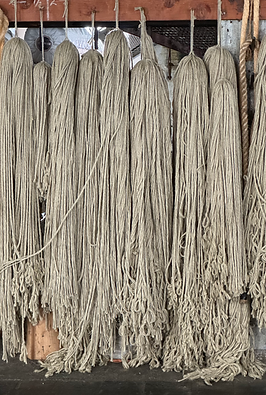
The Ropery houses an enormously long ‘rope walk’. By design, a ship’s rope had to be extremely long and continuous. No ‘magic knots’ can be used here! Because of this, the buildings in which the ropes were woven had to be extremely long as well, hence the need for a long rope walk. In fact, The Ropery is the longest brick building in the world, spanning approximately a 1/4 of a mile long. The building is so long in fact, that the Master Ropemakers ride bicycles from end to end rather than make a time-consuming walk. If you would like to see a bit more of The Ropery, check out Season 4 Episode 4 of Call the Midwife!
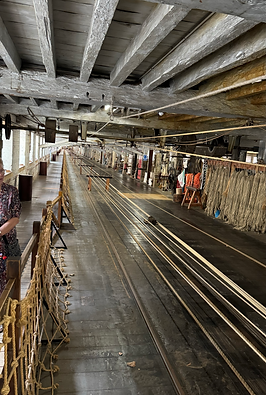
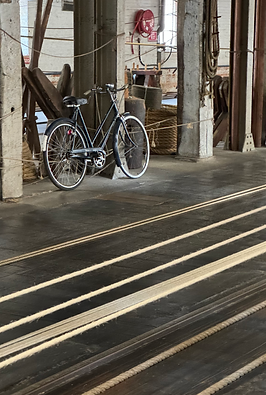
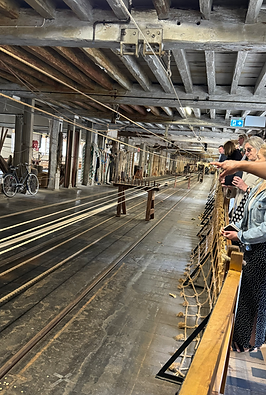
Sheep Unlock Terraforming
Now let's leave industrialization behind for a moment. I want you to picture the British Countryside.
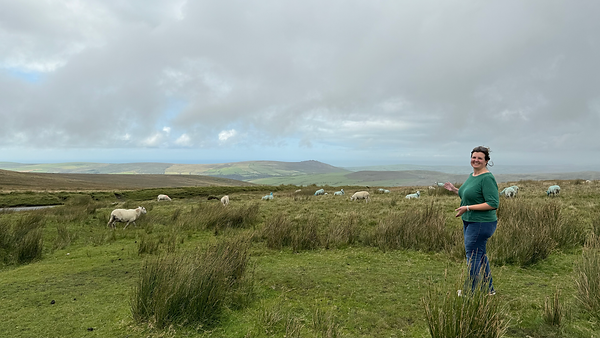
Undoubtedly, you’re thinking of long rolling pastures carpeted with wildflowers and dotted with sheep. At most maybe there is a skirting of trees at the edge, or a short stone wall blanketed by moss. And in a lot of ways you wouldn’t be wrong, but that isn’t the British countryside as it once was. The modern countryside has been terraformed by man for the cultivation of sheep and the sale of fleece. Driving through the countryside now, you can see large flocks of sheep traversing the land like dandelion seeds. They are unfettered by fences and undeterred by roads. A historical practice of common land grazing allowed them to rove and graze as they wish and that has continued to this day.
The British countryside in the 17th Century was a lot more forest and a lost less field but as the profitability of rearing sheep increased, more and more of the land was transformed to fit this purpose. Trees were cut down, land was leveled, and predators to sheep were removed. After all, any sheep losses or injuries meant a hit to the pocketbook. As Britain turned toward ‘pasture for profit’, the forests which once made up 75% of the island dwindled down to a mere 5% by the early 1900’s. Today this issue is a convoluted one because, as forests dwindled, so rose the beloved national image of the sheepherder, a symbol of British cultural identity.
Will there soon be no British forests left? Well I’m happy to say that luckily isn’t true. There are extensive efforts to re-wild Britain both in flora and fauna by multiple organizations including The Woodland Trust, Rewilding Britain and Reforest Britain. Currently, Britain is 13% forested and organizations like these hope to get that number up to 19% by 2050. They aim to achieve this goal by expanding the forest footprint, linking isolated pockets of woodland, and increasing the genetic diversity of plant and animal life. Now this is a long term project, one that future generations will benefit from. But if you are currently in search of an ancient British forest to visit, let me direct you!
One such remarkable forest that Andrew and I actually got to visit was Puzzlewood. Located in the Forest of Dean in Gloucestershire, Puzzlewood is an ancient woodland that has been iconically featured in several movies and television shows, including Harry Potter and the Deathly Hallows Part 1 and the 2020 adaption of The Secret Garden. This location owes its almost eerie uniqueness to the means in which it was formed. It is made up of scowls, which are more or less channels that form when erosion causes cave ceilings to collapse leaving behind the side walls. It is the perfect place for Robin Hood and his Merry Men to hide out!
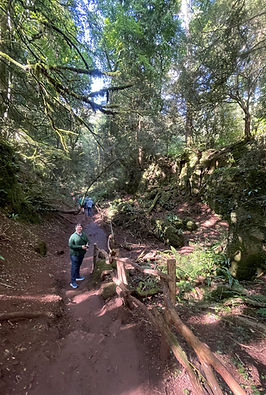

Weaving in the Ends at the Top

After many twists and turns through the ancient forest, we were able to find our way out of Puzzlewood. One of the next stops on our journey was Exmouth to check out some dapperly dressed postboxes!

In the UK, there is a long standing tradition of crocheting and knitting caps for their pillar-style postboxes. It has been a dream of mine to see these toppers in person, so when we planned our trip to Britain, I made sure to include the Exmouth Mail Trail on our itinerary. Through the sale of maps and merchandise, the Exmouth Mail Trail uses the popularity of their postbox toppers to raise funds for the charity Hospiscare. Armed with our map in hand, we hit the pavement and walked from topper to topper exploring the charming city-by-the-sea. Each topper (and there were dozens!) had a different theme and were expertly crocheted and knitted by a team of volunteers. Often these themes tell the story of a business sponsor or the history of the region. Each topper weaves a wonderful yarn for you to figuratively unravel as you gaze at it!

And if you don’t have time to go to Exmouth to see these charming chapeaus, rest assured that community installations like these pop up all over Britain! If you happen to live in the UK, a quick search for yarn-bombing events near you will surely bring a multitude of results. And for us in America, I’m happy to report that yarn-bombing events are becoming more and more popular here (though I am still trying to figure out how to dress up our own mailboxes)! In the meantime, I have a piggybank shaped like a British pillar postbox that is sorely in need of a hat. I plan to micro-crochet caps for it seasonally! So follow along on my Instagram to see my mini chapeaus!
Keep Calm and Stitch On!
Overdyed with history and textiles, we had to pack our bags to return to a place where the cacti don’t have to wear adorable beanies for warmth like they did in England.
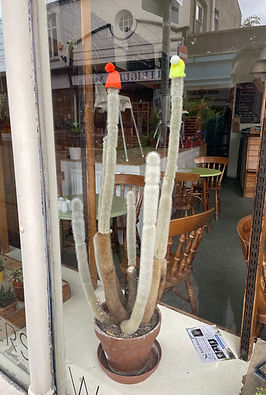
My UK fiber journey did not end when we left Britain. Tucked into my carry-on was this beautiful alpaca yarn I got in St. David’s in Wales. Just as we were walking to leave St. David’s, we spotted a small art market in the town square. Diverting from our path to our car, we headed in and I found a booth belonging to Ty Newydd Alpacas. The husband and wife team behind Ty Newydd Alpaca raise their own alpacas and use their fleece to make buttery soft and beautifully colored yarn. Incredibly, their entire production begins and ends in Wales which is increasing rare as most fleece is sent far away to be spun. Their single origin yarns are undyed, which means that my gorgeous grey yarn is from a gorgeous grey alpaca! And I can’t wait to see what I make with it!
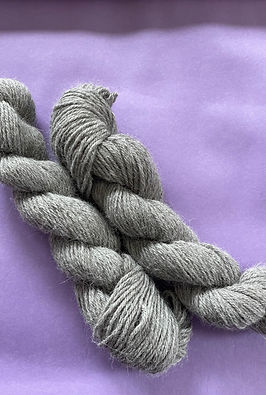
I leave you with this: Textiles are all around you, be curious! Whether it is a Bagpuss-esq plush or an intricately beaded kimono, there is a story to tell. We are all a part of this rich tapestry that is being ever-woven and there are always surprises between the stitches.
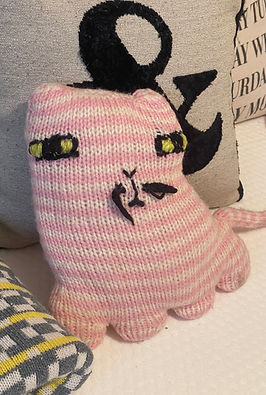

So examine the stitches, question the fiber, and if you see a friendly cat, pick it up and give it a cuddle. That will transform your 100% wool sweater into a one-of-a-kind 98% wool and 2% portly cathedral cat sweater!!!


